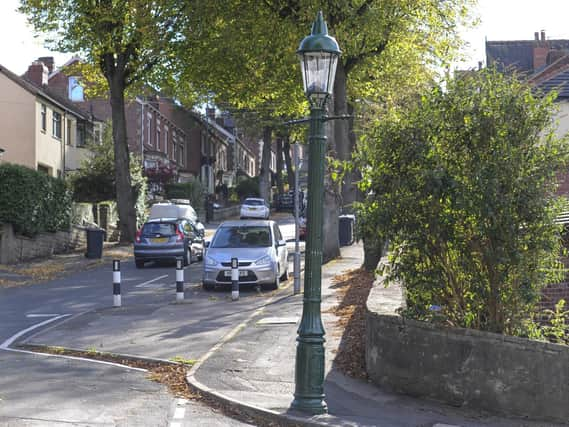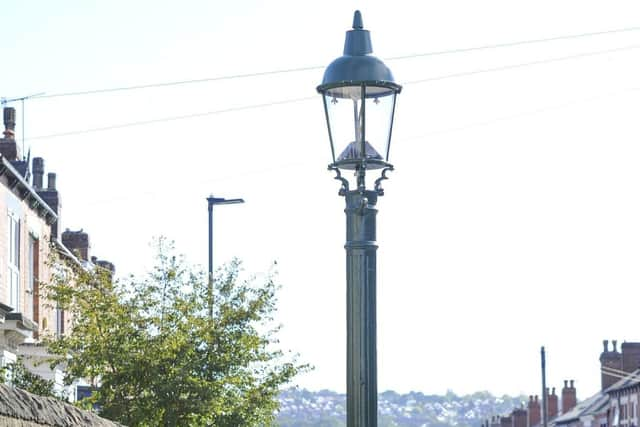New lease for historic lanterns


Working in partnership with English Heritage, Historic England and bespoke lantern manufacturer, Pudsey Diamond Engineering, 20 cast iron JE Webb Sewer Gas Destructor Lamps have now been restored to their original condition, and put back on display at locations around the city, by Amey.
The original lamps, which were first installed more than a century ago, have also been fitted with the latest LED lighting technology.


Advertisement
Hide AdAdvertisement
Hide AdCabinet member for environment and streetscene at Sheffield City Council, Coun Lewis Dagnall, said: 'Work to restore these Victorian gas lamps, as part of the Streets Ahead programme, was extremely important and will enable Sheffielders to enjoy their historic significance for years to come.
'The lamps offer a small but important reminder of years gone by and it's fantastic that they can be incorporated into our modern day world and moreover, serve an essential purpose by lighting up our streets.'
Designed to burn off dangerous methane and other gasses which accumulated in Victorian sewers, the lamps were located where there was known to be a problem with pockets of gas.
A temperature of 700 degrees fahrenheit was reached, which destroyed smells and bacteria as the sewer gas passed through the lamp to the open air.
Advertisement
Hide AdAdvertisement
Hide AdMore of these grade II listed lamps '“ invented by Joseph Webb, from Birmingham, in the late nineteenth century - were fitted in Sheffield than any other city, with 82 installed between 1914 and 1935 at various locations.
Sadly, over the years, many have been affected by vandalism, theft and natural ageing. With the conversion of street lights from gas to electric, the lamps slowly became obsolete.
But now the lamps have been repainted and fitted with specially designed solar power LED lights that closely replicate the original lighting style.
Chris Angel, chief electronics engineer at Pudsey Diamond Engineering, said:Â 'Refurbishing the lamps was a delicate process which involved retaining the existing lantern design while replacing the gas power.
Advertisement
Hide AdAdvertisement
Hide Ad'We developed a solution to replicate the lantern and gas supply mantle, which covers the flame and turns it into a brighter light. This has been reproduced using LED to mimic the gas mantle powered by solar energy and batteries in each lamp.
 'At the bottom of each lantern, solar panels are fitted at an angle and connected to a battery inside the top of the column. Panels store energy throughout the day which powers the battery and, in turn, the LED.'
Recognising their aesthetic contribution to Sheffield, the Environmental Planning Committee agreed in 1978 to retain and refurbish the surviving lamps. Four other lamps remain connected to the gas supply and haven't, as yet, been replaced. One lamp was removed from Rural Lane having been purchased by a local resident.
The refurbishments are part of the Streets Ahead works, which include upgrading the city's 68,000 street lights to state-of-the-art energy efficient LED lighting.
Advertisement
Hide AdAdvertisement
Hide AdCouncil contractor Amey has repainted the columns based on the existing heritage colour mid-Brunswick Green.
Nick Marriott, highways electrical operations manager at Amey, said: 'These lamps are of special historic interest and provide a nostalgic reminder of Sheffield's history and heritage.
'The work to preserve the lanterns' original material and unique features, while integrating the very latest light technology looks incredibly authentic.
'We are delighted to have been able to undertake work on these historic lights to enable them to shine bright in Sheffield long into the future.'
Advertisement
Hide AdAdvertisement
Hide AdThe gas destructor lamps can now be found at 20 location across the city, including: Kent Road in Heeley, Burnaby Crescent in Walkley, Upper Albert Road in Meersbrook, Frog Walk in Sharrow, Manor Oaks Road in Broomhill, Worrall Road in Worrall, Bishopscourt Road in Meersbrook, Toftwood Road in Crookes, Stothard Road in Crooks, School Road in Crookes, Leavy Greave Road in the city centre, Park Lane in Broomfield, Westbourne Road in Summerfield, Shiregreen Lane in Shiregreen, Oakland Road in Hillsborough, Fox Hill Road in Fox Hill, Jenkin Road in Jenkin, Eldon Street in the city centre, Stewart Road in Sharrow, South View Road in Sharrow, Alderson Road in Highfield, Lancing Road in Highfield, Mulehouse Road in Stannington, and Brincliffe Edge Road in Brincliffe.
Amey operates the Streets Ahead Highways Maintenance and Management service across Sheffield -Â one of the UK's largest local government highways partnerships.
Working with Sheffield City Council, the Streets Ahead contract is a huge city-wide 25 year highway maintenance project, working to improve and maintain 1,180 miles of road, 2,050 miles of pavement, 68,000 street lights, 36,000 highway trees, 28,000 street signs, 72,000 drainage gullies, 480 traffic signals, 18,000 items of street furniture, 2.9 million sqm of grass verges and over 600 bridges and highway structures.